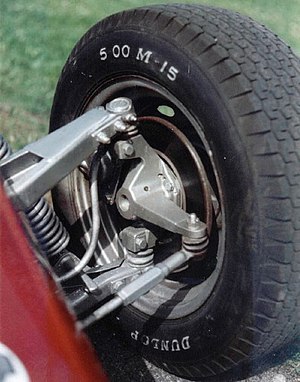Difference between revisions of "Kingpin"
m |
m |
||
| Line 3: | Line 3: | ||
| − | The '''kingpin''' is the main [[pivot]] in the steering mechanism of a [[automobile|car]] or other [[vehicle]]. Originally this was literally a steel pin on which the moveable, steerable [[wheel]] was mounted to the [[suspension (vehicle)|suspension]]. | + | The '''kingpin''' is the main [[pivot]] in the steering mechanism of a [[automobile|car]] or other [[vehicle]]. Originally this was literally a steel pin on which the moveable, steerable [[wheel]] was mounted to the [[suspension (vehicle)|suspension]]. Free to rotate on a single axis, it limited the degrees of freedom of motion of the rest of the front suspension. When its bearings were replaced starting in the 1950s by ball joints, more complicated suspension designs became available to designers. It is usually made of [[metal]]. |
| + | |||
| + | No longer restricted to moving like a pin, the part was not necessarily still called a king pin; but in newer designs, the term may be used not for an actual pin but the [[Axis of rotation|axis]] around which the steered wheels pivot. | ||
| + | |||
| + | The nipple at the front of a [[semi-trailer]] to connect to a [[fifth wheel coupling]] is also known as a king pin. | ||
| + | |||
| + | |||
| + | ==Kingpin Inclination== | ||
| + | |||
| + | On most modern designs, the king pin is set at an angle relative to the face of the wheel, as viewed from the front or back of the vehicle. This is the kingpin inclination or KPI. This has an important effect on the [[steering]], making it tend to return to the straight ahead or centre position. This is because the straight ahead position is where the wheel is at its highest point relative to the suspended body of the vehicle - the weight of the vehicle tends to turn the kingpin to this position. A second effect of the kingpin inclination is to set the [[scrub radius]] of the steered wheel. This is the offset between the tyre's contact point with the road surface and the projected axis of the steering down through the kingpin. If these points coincide, the scrub radius is zero. Zero scrub radius is possible without an inclined kingpin, but requires a deeply dished wheel so that the kingpin is at the centreline of the wheel. It's much more practical to incline the kingpin and use a less dished wheel, which also gives the self-centring effect. Zero scrub radius is not necessarily desirable - larger scrub radii lead to less steering effort (especially on vehicles without [[power steering]]) but more force applied to the steering components by road surface imperfections, braking, etc. Zero scrub radius isolates the steering from these effects but can lead to a "dead" feel for the driver which is undesirable, especially on performance vehicles. | ||
Latest revision as of 13:44, 12 November 2009
The kingpin is the main pivot in the steering mechanism of a car or other vehicle. Originally this was literally a steel pin on which the moveable, steerable wheel was mounted to the suspension. Free to rotate on a single axis, it limited the degrees of freedom of motion of the rest of the front suspension. When its bearings were replaced starting in the 1950s by ball joints, more complicated suspension designs became available to designers. It is usually made of metal.
No longer restricted to moving like a pin, the part was not necessarily still called a king pin; but in newer designs, the term may be used not for an actual pin but the axis around which the steered wheels pivot.
The nipple at the front of a semi-trailer to connect to a fifth wheel coupling is also known as a king pin.
Kingpin Inclination
On most modern designs, the king pin is set at an angle relative to the face of the wheel, as viewed from the front or back of the vehicle. This is the kingpin inclination or KPI. This has an important effect on the steering, making it tend to return to the straight ahead or centre position. This is because the straight ahead position is where the wheel is at its highest point relative to the suspended body of the vehicle - the weight of the vehicle tends to turn the kingpin to this position. A second effect of the kingpin inclination is to set the scrub radius of the steered wheel. This is the offset between the tyre's contact point with the road surface and the projected axis of the steering down through the kingpin. If these points coincide, the scrub radius is zero. Zero scrub radius is possible without an inclined kingpin, but requires a deeply dished wheel so that the kingpin is at the centreline of the wheel. It's much more practical to incline the kingpin and use a less dished wheel, which also gives the self-centring effect. Zero scrub radius is not necessarily desirable - larger scrub radii lead to less steering effort (especially on vehicles without power steering) but more force applied to the steering components by road surface imperfections, braking, etc. Zero scrub radius isolates the steering from these effects but can lead to a "dead" feel for the driver which is undesirable, especially on performance vehicles.
